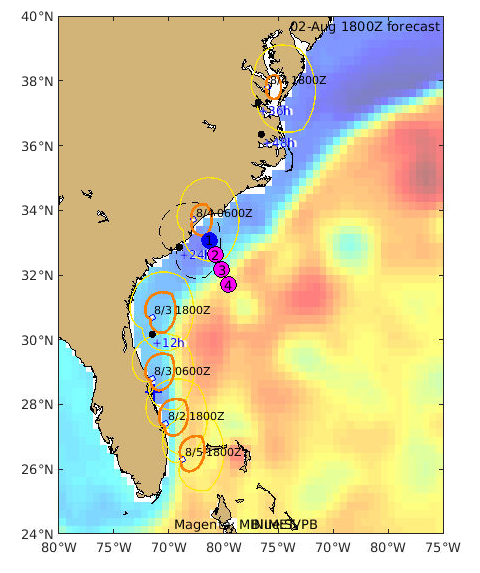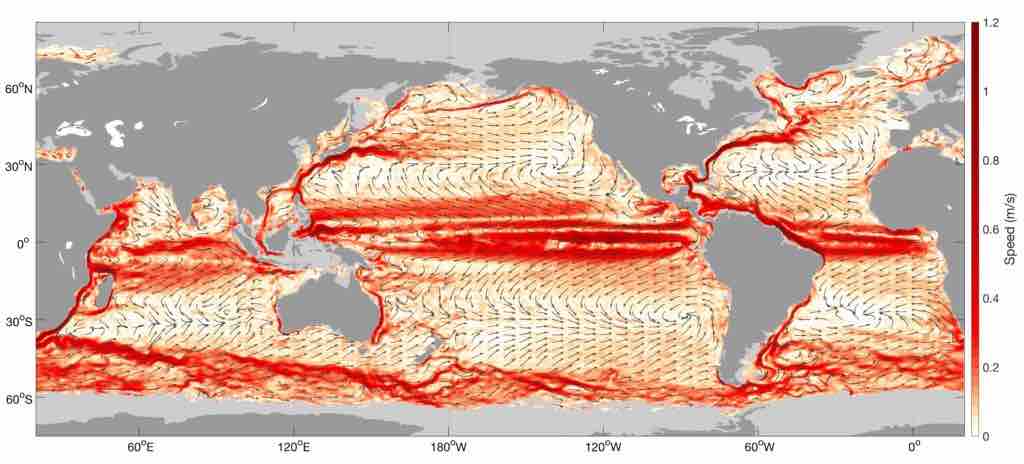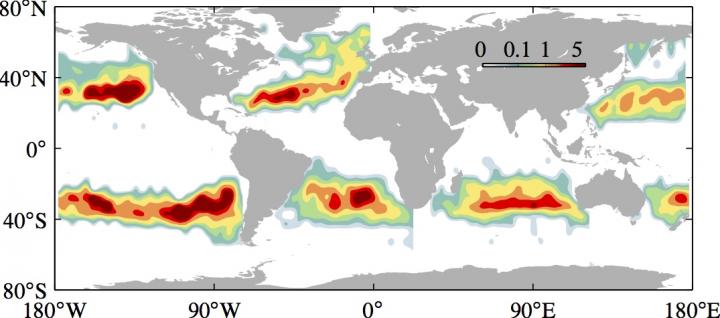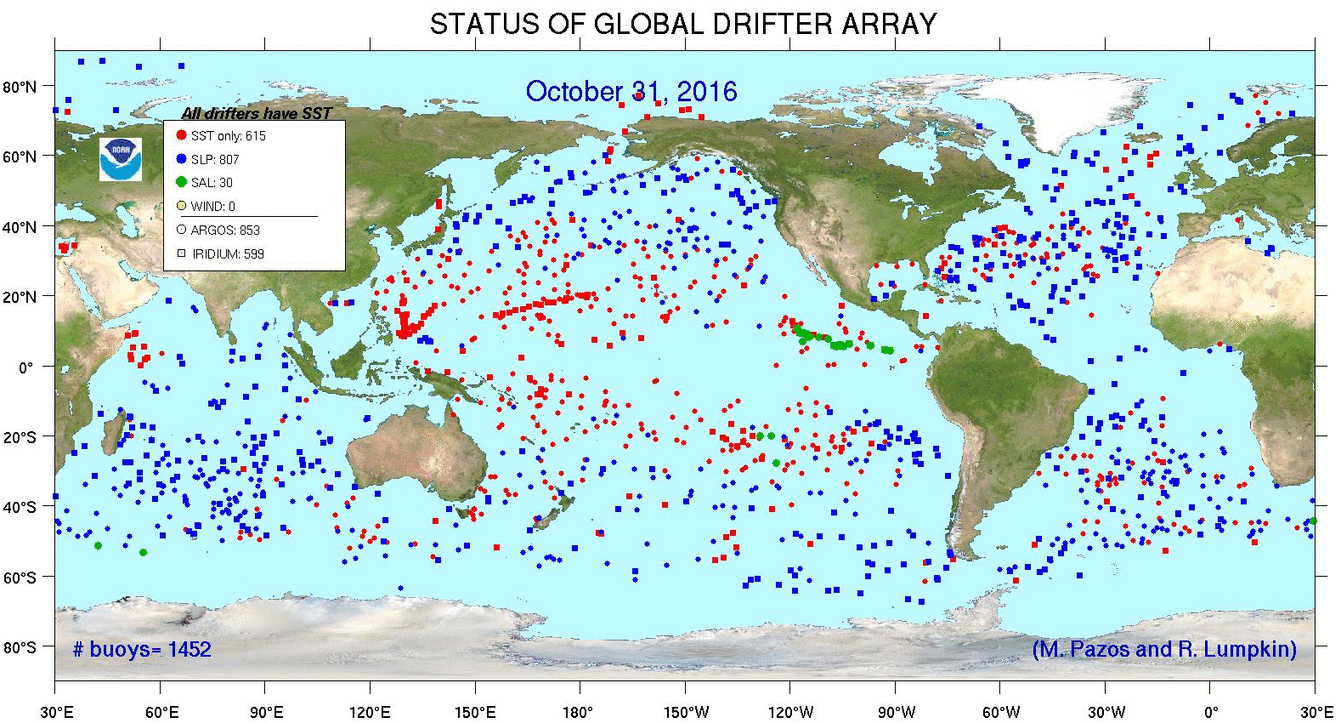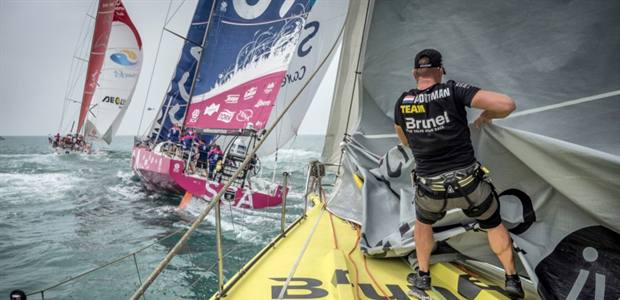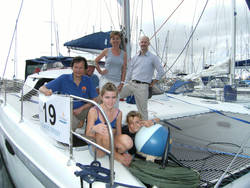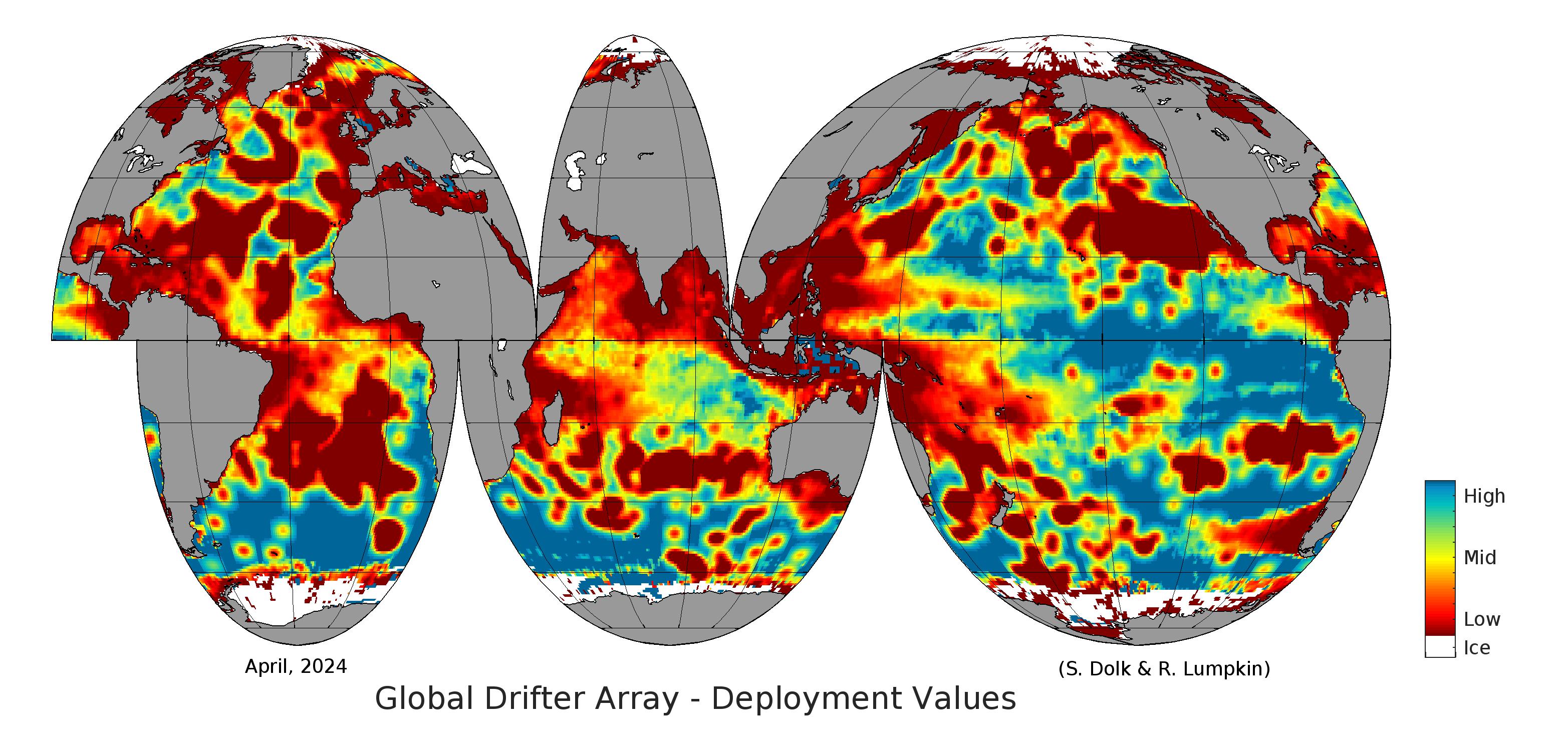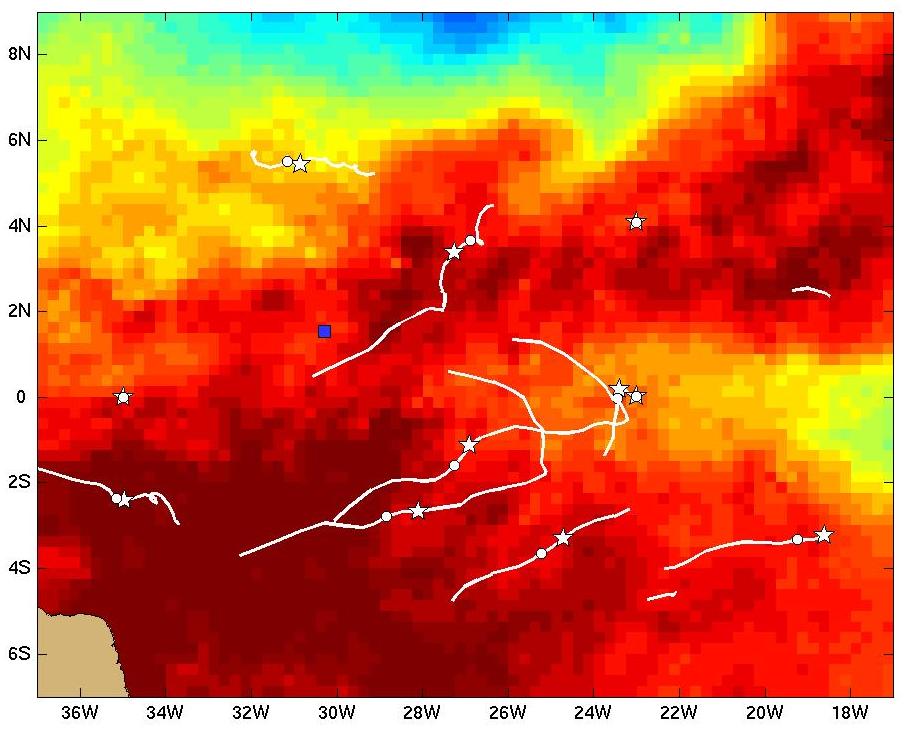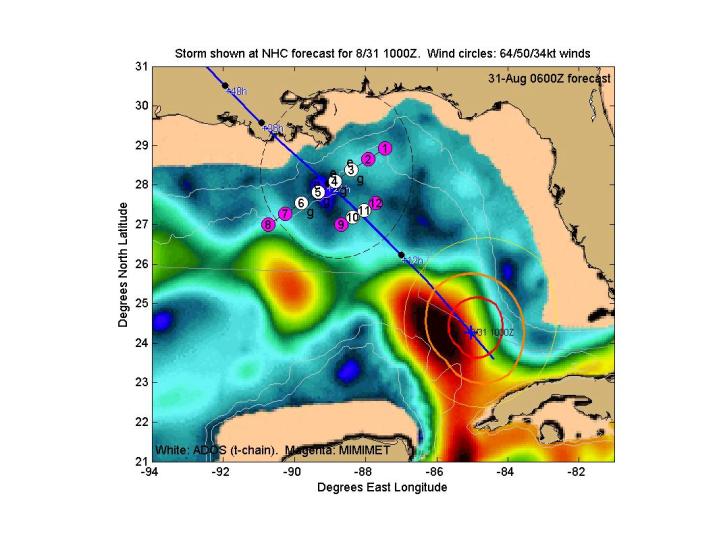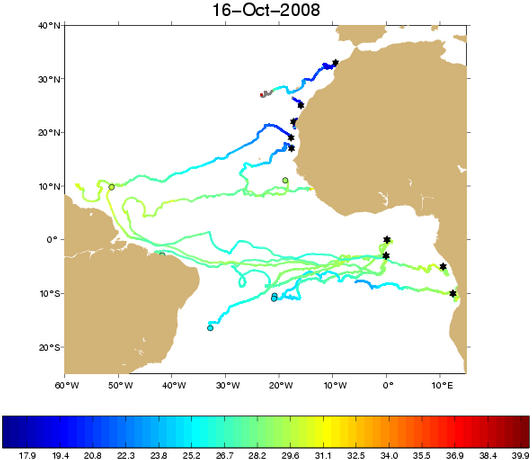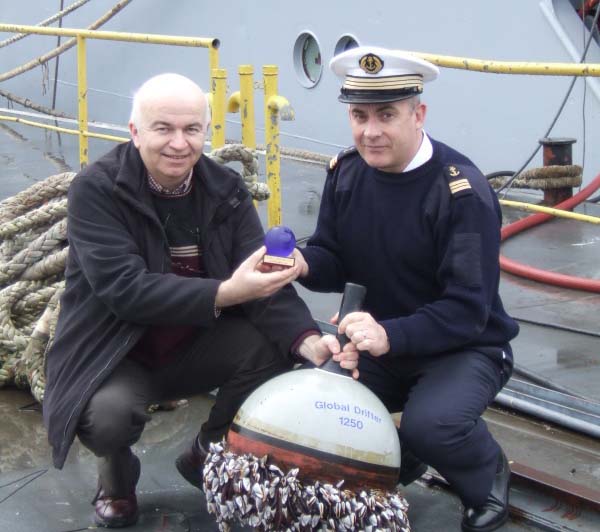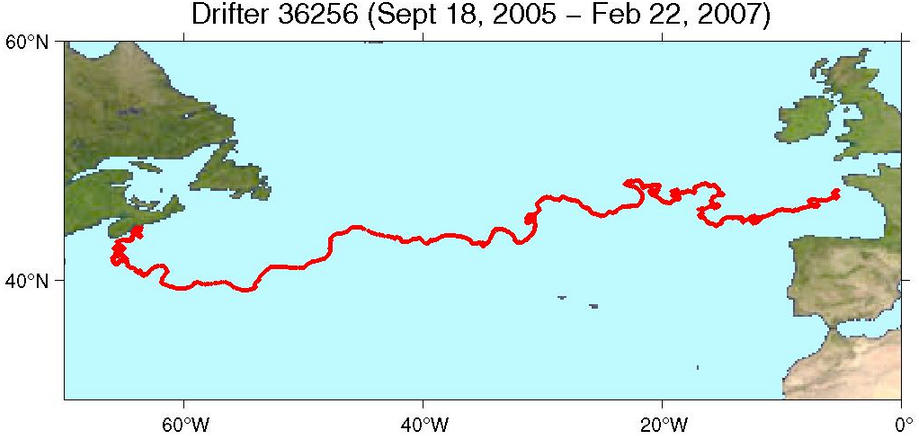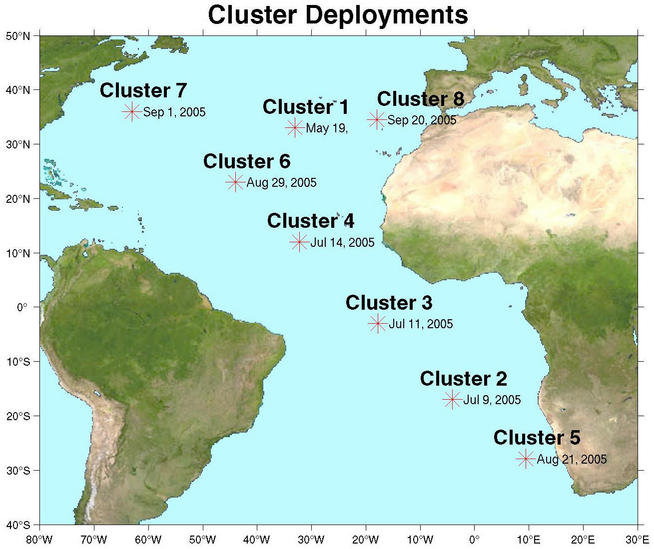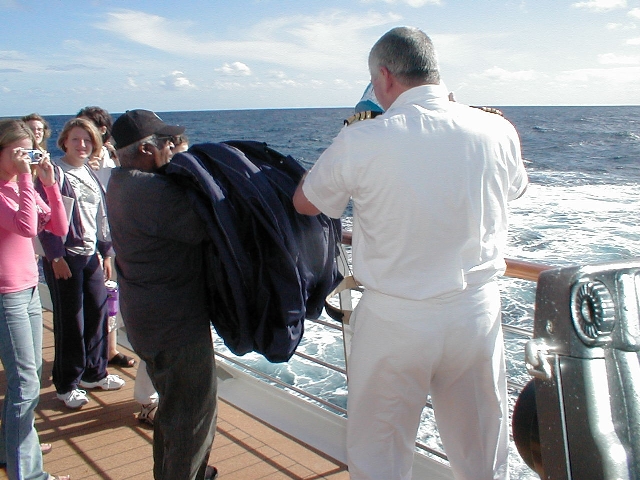GDP News Archive
Aug 3, 2020
Hurricane Isaias Drifter Deployments
Late on Sunday, August 2, an Air Force C-130J of the 53rd Reconnaissance Squadron “Hurricane Hunters” deployed eight drifters ahead of tropical cyclone Isaias off the Carolina coast. These deployments were coordinated by Rick Lumpkin of NOAA/AOML, working with NWS/NHC/CARCAH and Scripps Institution of Oceanography (SIO). The drifters, designed and built at SIO and funded by NOAA/GOMO, measure barometric pressure, sea surface temperature, ocean currents, wind speed and direction, and directional wave spectra. The data are now going onto the Global Telecommunications System for operational use by the National Weather Service and for better understanding how strong winds interact with the Gulf Stream system during wave formation and air-sea interactions. Isaias is forecast to reach Category 1 strength before reaching the array and subsequently making landfall.
April 08, 2020
New, NetCDF versions of all the 6-hour quality-controlled data are now available at the OSMC Interpolated Data ERDDAP server and at ftp://ftp.aoml.noaa.gov/phod/pub/lumpkin/netcdf/ (using a secure FTP client, such as FileZilla). These now include a large amount of additional metadata including deploying country, drogue cross-sectional area, surface buoy diameter, presence of subsurface float, starting voltage, and much more. For instructions on how to download the data, follow these Interpolated Data Request Instructions and enter the parameters of interest.
August 16, 2019
The Global Drifter Program now has a digital object identifier (doi) to reference publications incorporating quality-controlled 6-hour interpolated data from ocean surface drifting buoys. To view specifics pertaining to this doi, or to reference drifter data in your publication, please utilize https://doi.org/10.25921/7ntx-z961.
July 13, 2019
Version 1.03 of the hourly drifter data is now available (using a secure FTP client, such as FileZilla).
July 10, 2019
Study Improves Drifter-Based Estimates of Near-Surface Ocean Currents
Using 40 years of observations from the NOAA''s Global Drifter Program Array, the authors depict the annual mean speed of ocean currents at 15 meters depth. The vectors highlight the general direction of the large-scale circulation. Image provided by Lucas Laurindo, University of Miami Rosenstiel School of Marine and Atmospheric Science.
March 26, 2019
Atlantic Crossing...In a Barrel
During the 2019 PIRATA Northeast Extension and AEROSE cruise, the R/V Ronald H. Brown was able to rendezvous with Jean Jacques Savin, a Frenchman who has been at sea for 3 months, while trying to cross the Atlantic in a barrel [Full Story]. The journey has taken Jean Jacques longer than expected, so he asked if the R/V Ronald H. Brown could replenish his food and water supplies. Jean Jacques was in good health and is hopeful to reach the Caribbean in a month. After the rendezvous, as Jean Jacques (and his barrel) drifted away, the R/V Ronald H. Brown deployed two drifters for the Global Drifter Program.
May 1, 2018
25,000 Drifter Deployments!
NOAA's Global Drifter Program reached a significant milestone: the 25,000th drifter deployment since the start of the program in 1979. The drifter was one of four deployed by Volvo Ocean Race boats off the coast of Brazil during Leg 7 of the race. Worldwide deployments are coordinated by the Global Drifter Center at NOAA's Atlantic Oceanographic and Meteorological Laboratory in collaboration with numerous national and international partners. The drifters measure ocean currents, sea surface temperature (SST), and barometric pressure; these observations improve weather forecasts, ocean state estimation, satellite measurements of SST, and our understanding of how the ocean transports properties, tracers, and debris.
April 5, 2018
Outreach Activities
The GDP works closely with various organizations around the world to promote public awareness and increased utilization of drifting buoy data. To learn more about these efforts and GDP partner organizations, please visit our new Outreach Activities webpage.
February 14, 2017
A news item in EurekAlert, the news service of the AAAS, highlights a recent study that uses drifter data to improve our understanding of how ocean garbage gyres form. The study was lead by Francisco Beron-Vera of the University of Miami.
November 1, 2016
Iridium Transition
NOAA's' Global Drifter Program is transitioning the array from Argos to Iridium and including the newer Iridium data in its quality-controlled dataset. Read More
September 8, 2015
A recent analysis of drifter trajectories, conducted by CSIRO researcher David Griffin, has shown that debris from Malaysian Airlines flight MH370, recovered on La Reunion Island, could have plausibly come from the region currently being searched for aircraft wreckage.
March 12, 2015
Sailors participating in the Volvo Ocean Race help NOAA deploy drifters in the Southern Ocean to improve forecasts. Learn More
February 18, 2014
In conjunction with the Drifter Deployment Value Maps, you can now download the ascii file containing calculated values, by latitude and longitude.
December 2, 2013
While attempting to sail around the world, privately owned vessels participating in the Atlantic Odyssey will deploy drifting buoys during their voyage. The first of these drifter deployments was conducted on 26 November. For more information about the Atlantic Odyssey, and their deployment efforts, please Click Here.
July 18, 2013
In an effort to maximize drifter lifetimes and increase the number of data observations, the Global Drifter Program has created deployment value maps that highlight areas of need, while also identifying areas where drifters will die quickly. Assessing these values on a regional scale will allow program coordinators to better maximize their deployment efforts and increase the quality of drifter spacial coverage. To utilize these new value maps, click here
July 9, 2012
The Global Drifter Program metadata (directory) file has been updated to reflect the reassessed drogue loss dates for a large number of drifters. For more information, refer to Lumpkin et al. (2012) (JAOT, accepted October 2012) [PDF] . Many drifters now have earlier drogue off dates; we recommend that all users of the velocity data download this update. For the latest results of the ongoing reassessment, Click Here (using a secure FTP client, such as FileZilla).
April 27, 2012
In celebration of Earth Day,three students from the Key Biscayne K-8 Center, Key Biscayne, FL deployed a NOAA drifter today as part of the Adopt-A-Drifter Program. The three Florida students won a competition to describe the significance of the ocean in their lives. As part of this event, Dr. Rick Lumpkin was interviewed on the Weather Channel, where he described NOAA's Global Drifter Program, and the Adopt-A-Drifter outreach efforts. Watch interview
May 2011
A new study demonstrates that a significant fraction of drifters in the time period January 2004 through December 2008 may have undiagnosed drogue loss, resulting in significantly greater windage than experienced by drogued drifters. While the GDP assesses these data for drogue presence reanalysis, we recommend that users interested in exclusively drogue-on data use only the first 90 days of data for drifters deployed during this time period. [PDF]
October 2010
All of us within the Global Drifter Program are extremely saddened at the passing of Dr. Peter Niiler of the Scripps Institution of Oceanography. Peter championed the need for a global array of drifters, and through decades of intense effort he saw this dream fulfilled. Peter was an exceptional scientist and an artist who fully enjoyed a rich life, and his intelligence and wit will be greatly missed.
June 2010
In response to the Deepwater Horizon Oil Spill, the GDP has arranged for 36 drifters to be deployed in the Gulf of Mexico. The data from these drifters is being transmitted on the Global Telecommunication System for real-time distribution, and are available in ASCII format via ftp (using a secure FTP client, such as FileZilla). These drifters are being deployed in pairs, so that their relative spreading rates can be quantified. The subsequent trajectories of these drifters will map the ocean features in the Gulf, like the warm ring and the Loop Current, and help understand and forecast where these features will carry the oil.
On June 7-9, 6 drifter pairs were deployed from the R/V Walton Smith (chief scientist Michelle Wood) between the Deepwater Horizon site and the Dry Tortugas. The final two pairs were deployed close together in a convergence region where personnel aboard the Walton Smith observed oil being carried southward in a frontal jet.
In July, 12 drifter pairs are being deployed from the R/V Nancy Foster (chief scientist Ryan Smith). These deployments will be concentrated in the Loop Current and the large eddies north and northwest of the current.
January 2010
Movies illustrating the Evolution of the Global Drifter Array in five year intervals, since 1979 are available Here
June 2010
Shortly after the disappearance of Air France flight 447 on May 31, 2009 and the discovery of debris on June 2, the Drifter Data Assembly Center, in Miami, Florida, was contacted by the Hydrographic Center of the Brazilian Navy and French researchers from IFREMER, for in situ, near real time data from surface drifters in the area where the plane disappeared while crossing the Atlantic ocean in route from Rio de Janeiro, Brazil to Paris, France. Surface drifter trajectories are useful to estimate how far currents carried the floating debris from the crash site, where heavier equipment such as the "black box" recorders sank. Several drifters were indentified in the area, and to further populate the area, and obtain higher resolution current measurements,to help the search teams locate additional debris and bodies, the Hydrographic Center of the Brazilian Navy deployed five more drifters near the area of the crash on June 14. This active collaboration with the Brazilian Navy and IFREMER follows a long history of cooperation between AOML and international partners.
These drifter data are available in real time along with currents derived from altimetry sea height anomaly fields at:
September 11, 2008
An array of 9 drifters (5 minimets and 4 ADOS) was deployed in front of hurricane Ike before it landed in Houston. All drifters survived deployment and successfully transmitted their data on the Global Telecommunications System (GTS). Blue dots and black track lines show trajectories of drifters deployed in front of Gustav on August 31, 2008. Data available at:
http://www.aoml.noaa.gov/phod/trinanes/xbt.html (select "hurricane buoys" for "data set")
August 31, 2008
An array of 12 drifters (6 minimets and 6 ADOS) was deployed in front of hurricane Gustav before it landed in Louisiana. All drifters survived deployment and successfully transmitted their data on the Global Telecommunications System (GTS). Data available at:
http://www.aoml.noaa.gov/phod/trinanes/xbt.html (select "hurricane buoys" for "data set")
June 2008
In conjunction with the US Navy and NOAA, the United States Coast Guard Cutter (USCGC) DALLAS is performing various training sessions with West African countries as follow-up to the African Partnership Station (APS), which took place in the Gulf of Guinea in early 2008. As was performed by the HSV-2 SWIFT, the USCGC DALLAS is also deploying drifting buoys in the region as part of climate research and forecasting. In total, the USCGC DALLAS will deploy 10 SVP type drifters, which will help build upon the existing data set in the region.
March 28, 2008
Two new columns have been added to the"Details of All Drifters in the DAC database" (dirall.html) file, to show the ending latitude and ending longitude of each drifter in the database.
January 2008
The US Navy is presently undergoing a two-ship, six month training capacity building exercise in the Gulf of Guinea. AOML, as part of this effort, is providing drifting buoys, training materials and a trainer for this component of the Navy effort. This figure shows tracks of drifters deployed by the HSV 2 Swift. On each track, the star denotes deployment position, the circle shows last transmission position (no circle means, buoy is more than 3 days behind), and the color shows sea surface temperatures in degrees C.
During March 11-14, Mr. Shaun Dolk from the Driter Operations Center will be in Ghana to provide drifter, float and XBT training to regional researchers.
August 19, 2007
An array of 12 hurricane drifters (4 minimets and 8 ADOS) was deployed in the path of category 4 hurricane Dean approaching the Yucatan Peninsula, from a C-130J "Hurricane Hunter" plane. All drifters survived deployment and successfully transmitted their data on the Global Telecomunication System (GTS). Data available at:
http://www.aoml.noaa.gov/phod/trinanes/xbt.html select "hurricane buoys" for "data set".
February 21, 2007
Drifter 36256 (Drifter #1250) that completed the first component of the Global Observing System, deployed on Sep 18, 2005, was successfully recovered on Feb 21, 2007, in Brest, France, after a 521 days drifting across the Atlantic ocean. Both SST and Barometric pressure sensors were reporting good data until its recovery.
February 2007
Rick Lumpkin is participating in a CLIMODE cruise, aboard the R/V Knorr (US Navy-owned ship operated by WHOI for ocean research community), deploying 30 drifters (from a total of 60 to de deployed) in the North Atlantic. Three of these drifters are part of the Adopt-a-Drifter Program (ADP), established by NOAA/OCO for teachers K-12 from US and foreign countries to provide them with tools to integrate ocean observing system data into their curriculums.
February 2007
Limnology and Oceanography is hosting a Special Issue on scientific results obtained from autonomous and Lagrangian platforms and sensors (ALPS). All publication costs for this Special Issue will be covered, including Free Access Publication (the entire issue will be freely available online to maximize dissemination). We anticipate publication of 20-25 papers in this Special Issue.
Papers are invited from all disciplines in aquatic sciences. Interdisciplinary studies enabled by ALPS and numerical modeling studies using ALPS are also welcome.
For more details, including abstract and submission deadlines, see: http://aslo.org/lo/alps.html
October 16-20, 2006
Mayra Pazos and Rick Lumpkin (NOAA/AOML) attended the twenty-second Data Buoy Cooperation Panel (DBCP) DBCP meeting in La Jolla, California. During the DBCP, Mayra presented the results of the 2006 drifter performance ("ADB") study, while Rick presented the 2006 Global Drifter Program report and a scientific talk about drifter observations in the path of Category 5 hurricane Rita. A presentation prepared by Jessica Redman on the results of the re-evaluation of the drogue status was also presented by Bill Scuba (SIO) at the meeting.
May 1, 2006
The Drifter Data Assembly Center recently underwent a reevaluation of all drogue status on drifters deployed since 1998. Due to this, there has been a change in the drogue off date of several drifters. This either lengthened or shortened the life of the drogue depending on the new date chosen. The current database updated, through January 2006, has the correct drogue dates.
For more information, contact Mayra Pazos
October 17-21, 2005
Craig Engler and Mayra Pazos (NOAA/AOML) attended the twenty-first session of the Data Bouy Cooperation Panel DBCP jointly hosted by the National Meteorological Services and Naval Hydrographical Services in Buenos Aires, Argentina, on 17-21 October, 2005. Mayra and Craig presented on a comparison study of eight clusters of drifters, each from a different manufacturer, deployed at the same time and location in the Atlantic ocean. Download presentation (pdf).
September 25, 2005
Archbishop and Nobel Laureate Desmond Tutu and Captain Jeremy Kingston of the VOS ship MV Explorer deploy a drifter off the coast of South Africa. Archbiship Tutu was participating in the Semester At Sea program aboard the Explorer, which serves as a floating university campus. Every semester, more than 600 students sail aboard the Explorer for a learning experience that circumnavigates the globe. Two classes, one from the Congressional School of Virginia and the one from Elsies River High School in South Africa, adopted the drifter and will be tracking its passage through the South Atlantic.
September 18, 2005
Deployment of Drifter # 1250 makes the Global Drifter Program the first fully realized component of the Global Ocean Observing System (GOOS).
